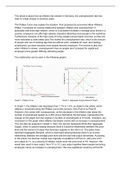This article is about how as inflation has slowed in Germany, the unemployment rate has
risen to a high unseen in previous years.
The Phillips Curve may explain the situation. First proposed by economist Alban Williams
Philips, it proposes an inverse relationship between inflation and unemployment. It
postulates that amid high inflation, which is a consistent increase in average price levels in a
country, employers can offer high salaries, therefore attracting more people to the workforce.
Furthermore, because of the high costs of living, people pursue higher incomes, so they are
more motivated to seek better jobs.This makes the unemployment rate, which is the amount
of people who are of working age that are without work, available for work, and seeking
employment, go down because more people become employed. The reverse is also true;
when inflation is slower, unemployment rises as people aren’t pressed for capital and
employers have greater difficulty attracting people.
The relationship can be seen in the following graphs:
Graph 1. Phillips Curve Graph 2. Aggregate Supply-Demand Graph
In Graph 1, the inflation rate decreases from 1.7% to 1.4%, as stated in the article, which
reflects a movement along the Phillips Curve (the red line), from Point A to Point B.
However, this comes with consequences, as the decrease in the inflation rate raises the
number of unemployed people by 4,000 versus that before the decrease, representing the
change on the graph from the original X (number of unemployed) to X+4,000. Therefore, any
movement on the graph when inflation decreases comes with an increase in unemployment.
This can also be analyzed in Graph 2. Here, the red line represents Short-Run Aggregate
Supply, which is upward-sloping because there is a positive relationship between the price
level and the amount of output that Germany supplies in the short run. The green lines
represent Aggregate Demand, which is downward-sloping because there is an inverse
relationship between the average price level and the total real output demanded. According
to the article, the German market was originally at equilibrium at Point A, with price at P1
and output at Y1, so a slowing of inflation would lower the price level to P2. However, this
would also result in less output, from Y1 to Y2. Less output signifies fewer people becoming
employed, hence an increase in unemployment. The new equilibrium would be at Point B.





